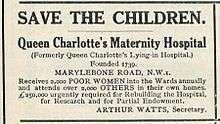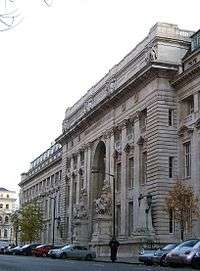Queen Charlotte's and Chelsea Hospital
| Queen Charlotte's and Chelsea Hospital | |
|---|---|
| Imperial College Healthcare NHS Trust | |
.jpg) Queen Charlotte's and Chelsea Hospital main building. | |
| Geography | |
| Location | East Acton, London, England, United Kingdom |
| Organisation | |
| Care system | Public NHS |
| Hospital type | Specialist |
| Affiliated university | Imperial College London |
| Services | |
| Emergency department | No Accident & Emergency |
| Speciality | Maternity, women's and children's services |
| History | |
| Founded | 1739 |
| Links | |
| Website | http://www.imperial.nhs.uk/qcch/index.htm Imperial College Healthcare NHS Trust, Queen Charlotte's |
| Lists | Hospitals in England |
Queen Charlotte's and Chelsea Hospital is one of the oldest maternity hospitals in Europe, dating from 1739, and until 1999[1] occupied a site at 339-351 Goldhawk Road, Hammersmith, London W6 0XG. It is now located between East Acton and White City, where it shares a site with the Hammersmith Hospital.
History
Foundation date
There is some confusion over the precise date of foundation. The hospital strictly dates its foundation to 1739 when Sir Richard Manningham founded a hospital of lying-in beds in a 17-room house in Jermyn Street.[2] This was called the General Lying in Hospital, and was the first of its kind in Britain. Some sources date the foundation to 1752, the year in which the hospital relocated from Jermyn Street to St Marylebone, and first became a teaching institution.[3] Still other sources quote 1782 as the foundation, as this is the year in which (on 10 January) a licence was granted to the hospital charity by the Justices of the County of Middlesex (at that time a legal requirement for a maternity hospital).
The hospital appears to have arisen out of the 1739 foundation, but with varying degrees of recognition, developing over time. The inter-relation of these different dates, and the complex supporting evidence for each of them, is fully discussed and documented in the first chapter of "The History of Queen Charlotte's Lying-in Hospital", a large volume published in 1885, and written by Thomas Ryan who was then Secretary to the hospital trustees.[4]
Royal patronage
In 1809 Queen Charlotte, the wife of King George III, became its patron, having been persuaded by her son to become involved. A Royal Charter was incorporated in 1885 and when this was amended in 1924 the present name came into use. The hospital subsequently merged with the Chelsea Hospital for Women and is now based at the Hammersmith Hospital site in West London to which it was relocated in 1998. The hospital was originally a voluntary hospital. At different times over the years the hospital has been located in Bayswater, on Marylebone Road and at Ravenscourt Park. The Chelsea Hospital also moved site and used to be based in Chelsea, in the building now occupied by the Chelsea Wing at the Brompton Hospital.
Summary of key historical dates
- 1739 Charitable infirmary founded in Jermyn Street for women in dire need.
- 1752 Now called the General Lying-in Hospital, services move four times, ending up in a privately owned house in Bayswater.
- 1782 On 10 January a licence is granted by the Justices of the County of Middlesex, for the lying-in hospital.
- Early 1800s Saved from extinction by the sixth son of King George III, Prince Augustus Frederick, Duke of Sussex, who persuaded his mother Queen Charlotte to become patron.
- 1809 Its name changed to the Queen’s Lying-in Hospital, then later to Queen Charlotte’s Lying-in Hospital, followed by Queen Charlotte’s Maternity Hospital.
- 1856 Following two moves, the hospital relocated to Marylebone Road.
- 1885 An extensive historical survey of the hospital is published by the trustees, written by their Secretary, Thomas Ryan.
- 1936 The Chiswick isolation block in Goldhawk Road opened to help save lives of mothers dying from infection after birth, then known as ‘childbed fever’.
- 1940 The hospital moved to Chiswick Road due to high risk of bombing during the Blitz.
- 1948 At the creation of the NHS Queen Charlotte’s linked up with the Chelsea Hospital for Women to form a combined teaching school.
- 1988 The Chelsea Hospital for Women moved from Fulham Road to share the Chiswick Road site under the new title Queen Charlotte’s & Chelsea Hospital.
- 2000 The ninth move was made to the current purpose built site in Du Cane Road, on the border of East Acton and White City.
- 2001 Official opening in May by HRH The Princess Royal.
Queen Charlotte's and Chelsea Hospital today
.jpg)
Location
Today the hospital occupies a site on Du Cane Road, East Acton, on the border with neighbouring White City, where a modern purpose built building is provided. The hospital is located immediately beside the Hammersmith Hospital, and there is a physical connection between the two buildings, although they operate entirely independently, whilst sharing some infrastructure resources, including car parking. The hospital is accessible by public transport; the nearest bus stops are "Wulfstan Street" and "Hammersmith Hospital"; the nearest tube station is East Acton (Central Line).
Operation
The hospital is part of Imperial College Healthcare NHS Trust. It is a postgraduate teaching hospital, as well as being a major provider of maternity services to the London Borough of Hammersmith and Fulham, with around 5000 births/year.
It has a particular reputation for its fœtal medicine services, based at the Centre for Fœtal Care which is now led by Mr Christoph Lees,[5] who moved from Cambridge in 2013. The CFC has expertise in the management of complicated and monochorionic twin pregnancies. It also has a strong reputation for its reproductive medicines services and in particular the IVF unit which is one of the largest in the country. The early pregnancy and acute gynaecology service is led by Professor Tom Bourne[6] and Ms Catriona Stalder and has a national and international reputation and has a large research output. The unit sees over 15,000 emergency gynaecology cases each year, leading to 1,500 patients being admitted to hospital.The hospital is the home of the West London gynaecological cancer centre and is a tertiary referral centre. The team was recently joined by Professor Christina Fotopulou from the Charite Hospital in Berlin who has a major interest in radical surgery for ovarian and other gynaecological cancers. The gynaecological cancer service at Queen Charlotte’s & Chelsea Hospital serves a population of two million people across north west London and beyond. The unit treats approaching 500 women with gynaecological cancers each year.
Famous births
Actors Benedict Cumberbatch, Daniel Radcliffe, Mischa Barton, and Dame Helen Mirren (who in 1994 portrayed the hospital's namesake in The Madness of King George), musicians Zak Starkey and Steve Jones, athlete and politician Sebastian Coe, and writer Graeme K Talboys and Laurence Thirkettle are among the many prominent people born at Queen Charlotte's and Chelsea Hospital.
Other units on site
In addition to sharing the Du Cane Road site with the Hammersmith Hospital, several other medical facilities are also located on the same site.
Queen Charlotte's and Chelsea Hospital is the base for the Institute of Obstetrics and Gynaecology of the former Royal Postgraduate Medical School, which became part of Imperial College London.
In the early 1980s Professor Michael de Swiet established a specialist "maternal medicine" unit for London, recognising that a need existed for specialist care to be offered to pregnant women who suffered from pre-existing medical conditions, or conditions that developed during pregnancy, whose treatment might impact upon the pregnancy.[7] The unit is known as the de Swiet Obstetric Medicine Centre, and is currently housed in a small suite of rooms on the second floor of the Queen Charlotte's and Chelsea Hospital.

The hospital is immediately adjacent to the Institute of Reproductive and Developmental Biology (IRDB), which was established by Professor Robert Winston (Lord Winston of Hammersmith) in 2001. It is directed by Professor Phillip Bennett,[8] and undertakes research in all aspects of reproductive biology. The Institute is located within the purpose-built 'Wolfson and Weston Research Centre for Family Health'. Being adjacent to the Queen Charlotte's and Chelsea Hospital, and with links to clinical academic obstetrics and gynaecology at St Mary's Hospital, it is ideally placed to facilitate the translation of research into improvements in Women’s Health, fertility, reproduction, pregnancy and childbirth. Outstanding molecular and cell biology resources are available and supported by central core services and ‘state-of-the-art’ laboratories.
Funded research
Bliss, the special care baby charity, are currently funding Dr Lydia Tyszczuk's simulation training project.
See also
References
- ↑ Google Earth imagery shows the site being demolished in September 1999.
- ↑ See brief history at AIM25 historical archive record website.
- ↑ See the history page of the official NHS Trust sensate.
- ↑ Available as an on-line scanned document: The History of Queen Charlotte's Lying-in Hospital from its foundation in 1752 to the present time, with an account of its objects and present state, published 1885 by Hutchings & Crowsley, written by Thomas Ryan, Hospital Secretary.
- ↑ "Christoph Lees - LinkedIn".
- ↑ "Home - Professor Tom Bourne".
- ↑ History and purposes of unit all stated here Archived September 3, 2014, at the Wayback Machine..
- ↑ "Home - Professor Phillip Bennett".
External links
![]() Media related to Queen Charlotte's and Chelsea Hospital at Wikimedia Commons
Media related to Queen Charlotte's and Chelsea Hospital at Wikimedia Commons
Coordinates: 51°30′58″N 0°14′14″W / 51.5161°N 0.2373°W
